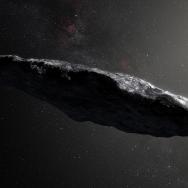The XENON1T detector, tucked into an Italian mountainside to search for signs of a mysterious substance in the universe called dark matter, has picked up a new bump in the data that cannot be explained by current models.
An analysis of this excess signal, led by physicists from the University of Chicago, the University of California, San Diego, and the University of Zurich and vetted by the entire XENON collaboration, suggests that it may be evidence of new physics—or an unexpected radioactive contaminant. The results were announced in a seminar on June 17.
“An excess signal is always something exciting! Sometimes you discover that the excess is just due to an unknown background, or it may be a sign of a fundamental new discovery about our universe,” said Assoc. Prof. Luca Grandi, a study co-author. “What we see is a solid and significant excess above our expectations; however, XENON1T is not sensitive enough to discriminate between the various potential origins.”
The XENON project is a collaboration of over 160 scientists from across the globe who seek to unearth the mysteries of dark matter. The group is hard at work building the next generation of the detector, called XENONnT. When the more sensitive detector begins collecting data—potentially by the end of this year—the scientists hope to figure out which of their hypotheses is responsible for the excess signal at low energies.
XENON’s search for new physics
Dark matter makes up the vast majority of matter in the universe, but scientists still do not know the nature of this exotic material. It does not block or give off light and rarely interacts with the ordinary matter that makes up everything we can see in the universe.

To try to glimpse this elusive material, scientists in the XENON collaboration built the world’s most sensitive dark matter detector, XENON1T. This huge detector, filled with over three tons of liquid xenon, is protected from radiation by a three-story-tall tank of ultra-pure water and housed in an underground laboratory beneath a mountain at Gran Sasso National Laboratory in Italy.
Within this uniquely pristine environment, an instrument called a time projection chamber monitors signals of light and electrical charge that are triggered whenever a subatomic particle interacts with the pool of xenon. If a particle of dark matter bumped into a xenon atom, it should theoretically show up in the data. Though the chamber, designed and maintained with the help of UChicago scientists, is extremely sensitive, these interaction events are incredibly rare—it takes nearly a year to collect enough data for a thorough study.
XENON1T’s xenon-filled chamber is made from incredibly high purity materials, but there is still an unavoidable level of background radiation from the materials that make up the detector itself.
“We do a ton of analysis to predict what backgrounds are present in the detector, along with their expected rates and energies,” said UChicago graduate student Evan Shockley, one of three corresponding authors of the study. “Then we can compare these predictions with the data and see if they agree.”
But upon careful consideration of the data, Shockley and his colleagues concluded the signal was above the expected background at low energies and could not be explained by any existing models or known sources of contamination.
There were 53 unexplained events over the year-long experiment—enough to be significant, but not enough to distinguish between a background contaminant or a physics breakthrough.
“When you push to the edge of your detector’s sensitivity in the search for these elusive particles you sometime bump into unexpected backgrounds that you hadn’t previously accounted for,” said Grandi. “XENONnT, the larger detector that we are preparing for operation, should shed some light on this and help us discriminate among the various explanations.”
The possible candidates
The XENON1T detector was designed primarily to search for signals that may indicate the existence of one of the leading candidates for what dark matter might look like—large, heavy particles, known as weakly interacting massive particles (WIMPs).

But this ultra-sensitive detector could also pick up other signals that may teach us about the universe. Two possibilities for the signal they saw would be a hypothetical particle from the sun called a solar axion; or particles called neutrinos also coming from the sun, but with unexpected magnetic characteristics. If this measurement does correspond to either of these exotic particles, it would be a revolutionary finding and answer some of the most prominent questions about the physics of our universe.
“Our data supports the solar axion hypothesis most strongly. However, if we did indeed observe solar axion interactions, the properties of the axions we observed would be in contrast with results from astrophysical observations,” said Grandi.
But another possibility is that the signal is actually related to an unexpected contaminant in the detector. The excess signal, Shockley explained, looks similar to the energy pattern created by the radioactive decay of tritium. “Tritium is a hydrogen atom with two neutrons,” he said. “It’s not very common. But since our detector is so sensitive, the presence of even a few tritium atoms in the detector could result in an excess like the one we observed.” (He and his fellow researchers had not previously looked for tritium contamination, because tritium is so rare that it was thought unlikely to exist in their ultrapure materials.)
It’s too close to tell which one it is with the current data, but Grandi and his group may get definitive answers when the XENON collaboration’s newest dark matter detector, XENONnT, becomes operational later this year.
“Dark matter makes up the vast majority of matter in the universe, but scientists still do not know the nature of this exotic material.”
XENONnT upgrade for higher sensitivity
At the moment, XENON1T is already the world’s most sensitive dark matter detector. To push its capabilities even further, Grandi’s group and UChicago research engineer manager Ben Stillwell designed improvements to the detector that will contribute to an increase in its sensitivity by a factor of 10. The upgraded XENONnT detector will complete measurements more quickly and with better signal quality.
“To increase the sensitivity, we have increased the size of the detector to allow for three times more xenon. We’ve also done a lot of work to carefully select the materials that we use and further refined the detector design to reduce the background,” explained Jacques Pienaar, UChicago postdoc and the analysis coordinator for XENON1T and XENONnT.
Pienaar and Grandi spent the early part of 2020 at Gran Sasso leading the construction of XENONnT’s time projection chamber. With the threat of COVID-19 growing in Italy, they managed to complete the construction of the new detector just a few days into the quarantine lockdown. The detector is now in a stable, clean condition and the final preparations will occur later this year.









